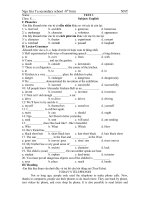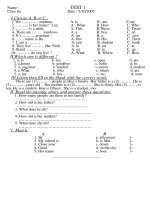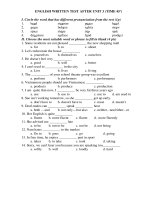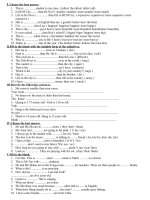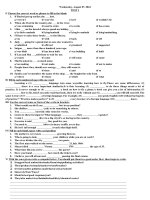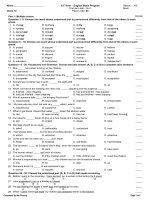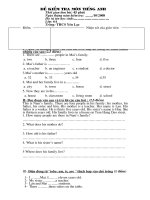Biology subject test (1)
Bạn đang xem bản rút gọn của tài liệu. Xem và tải ngay bản đầy đủ của tài liệu tại đây (122.9 KB, 14 trang )
MCAT Subject Tests
Dear Future Doctor,
The following Subject Test and explanations contains questions not in test format and
should be used to practice and to assess your mastery of the foundation content
necessary for success on the MCAT. Simply memorizing facts is not sufficient to achieve
high scores; however, an incomplete understanding of basic science knowledge will limit
your ability to think critically. Think of building your content knowledge as learning the
vocabulary and practicing MCAT-like questions as actually speaking.
All rights are reserved pursuant to the copyright laws and the contract clause in your
enrollment agreement and as printed below. Misdemeanor and felony infractions can
severely limit your ability to be accepted to a medical program and a conviction can
result in the removal of a medical license. We offer this material for your practice in your
own home as a courtesy and privilege. Practice today so that you can perform on test
day; this material was designed to give you every advantage on the MCAT and we wish
you the best of luck in your preparation.
Sincerely,
Albert Chen
Executive Director, Pre-Health Research and Development
Kaplan Test Prep
© 2003 Kaplan, Inc.
All rights reserved. No part of this book may be reproduced in any form, by Photostat, microfilm,
xerography or any other means, or incorporated into any information retrieval system, electronic
or mechanical without the written permission of Kaplan, Inc. This book may not be duplicated,
distributed or resold, pursuant to the terms of your Kaplan Enrollment Agreement.
_________________________________________________________________________ B I O L O G Y S U B J E C T T E S T 1
Biology Subject Test 1
1.
C6H12O6 + O2 ∅ CO2 + H2O
5.
This process is completed
A.
B.
C.
D.
E.
A.
B.
C.
D.
E.
in the cytoplasm.
in the area of the cell membrane.
in the nucleus.
in the mitochondria.
in the area around the ribosomes.
6.
2.
Which statement about gastrulation is false?
A. In the amphibian, the initial site of gastrulation
occurs at the gray crescent.
B. As a consequence of gastrulation the embryo now
consists of two germ layers: ectoderm and
endoderm.
C. In the amphibian, the infolding through which
blastula cells migrate during gastrulation is called
the blastopore.
D. The primitive gut that results from gastrulation is
called the archenteron.
E. Mesoderm develops during gastrulation.
3.
4.
7.
Mesoderm : heart
Ectoderm : nervous system
Endoderm : intestinal tract
Mesoderm : pancreas
Ectoderm : epidermis of skin
Point
Silent
Insertion
Frameshift
All of the above are types of genetic mutations
Can self-replicate
Can act as a hormone
Can catalyze chemical reactions
Acts in cell membrane trafficking
Can bind foreign materials
A typical human gamete
A.
B.
C.
D.
contains a haploid number of genes.
will always contain an X or Y chromosome.
is a result of the meiotic process.
has genetic material that has undergone
recombination.
E. All of the above
8.
All of the following organelles are membrane-bound
except the
A.
B.
C.
D.
E.
Which of the following is not a type of genetic
mutation?
A.
B.
C.
D.
E.
It is a long filament of RNA.
It is produced in the nucleolus.
It has a poly-A tail.
It has some short double-stranded segments.
It is the template for protein synthesis.
Which is not a characteristic of proteins?
A.
B.
C.
D.
E.
Which of the following associations of germinal tissues
and developed tissues is incorrect?
A.
B.
C.
D.
E.
Which of the following is a characteristic of tRNA?
9
rough endoplasmic reticulum.
Golgi apparatus.
nucleus.
mitochondria.
ribosome.
Which statement about cyclic AMP (cAMP) is NOT
true?
A. cAMP is formed from ATP.
B. The enzyme that catalyzes the formation of cAMP
is adenylate cyclase.
C. The enzyme that catalyzes cAMP formation is
generally located in the cytoplasm.
D. Membrane receptors are capable of activating the
enzyme that forms cAMP.
E. cAMP is regarded as a second messenger, since it
can trigger a cascade of intracellular reactions
after a hormone binds to the cell membrane.
KAPLAN ________________________________________________________________ 1
B I O L O G Y S U B J E C T T E S T 1 ____________________________________________________________________________
10. All of the following about the Krebs cycle are true
EXCEPT
A. the Krebs cycle occurs in the matrix of the
mitochondrion.
B. the Krebs cycle is linked to glycolysis by pyruvate.
C. the Krebs cycle is the single greatest direct source
of ATP in the cell.
D. citrate is an intermediate in the Krebs cycle.
E. the Krebs cycle produces nucleotides such as
NADH and FADH2.
11. Which statement about glycolysis is NOT true?
A. Glycolysis converts a single molecule of glucose
into two molecules of pyruvate.
B. Glycolysis can produce a net total of two ATPs.
C. The end-product of glycolysis can form ethanol,
CO2 lactate, and pyruvic acid.
D. During glycolysis FADH2 is produced.
E. During glycolysis NADH is produced.
12. Which of the following statements about oxidative
phosphorylation is NOT correct?
A. It occurs on the inner membrane of the
mitochondrion.
B. It involves O2 as the final electron acceptor.
C. It produces two ATPs for the FADH2.
D. It can occur under anaerobic conditions.
E. It involves a cytochrome electron transport chain.
13. Glycogen
A.
B.
C.
D.
E.
is a storage polymer of glucose.
is found in both animals and plants.
is degraded by a process called glycogenesis.
is synthesized by a process called glycogenolysis.
is an unbranched molecule.
14. In a cell that secretes large quantities of protein, such
as a pancreatic exocrine cell, there is (are)
I. an abundance of rough endoplasmic reticulum.
II. a large Golgi apparatus.
III. prominent nucleoli.
A.
B.
C.
D.
E.
2
I and II
II and III
I and III
I only
I, II, and III
15. Cells that are involved in active transport, such as cells
of the intestinal epithelium, utilize large quantities of
ATP. In such cells there are
A.
B.
C.
D.
E.
high levels of adenylate cyclase activity.
many polyribosomes.
many mitochondria.
high levels of DNA synthesis.
many lysosomes.
16. The process by which a cell engulfs large particulate
matter is called
A.
B.
C.
D.
E.
pinocytosis.
exocytosis.
cytokinesis.
phagocytosis.
osmosis.
17. The genetic code is considered degenerate because
A. more than one codon can code for a single amino
acid.
B. one codon can code for multiple amino acids.
C. more than one anticodon can bind to a given
codon.
D. only one anticodon can bind to a given codon.
E. None of the above
18. Which statement regarding protein synthesis is false?
A. tRNA molecules shuttle amino acids that are
incorporated into the protein.
B. tRNA molecules have the amino acid bound to the
3' end of the molecule.
C. The process does not require energy.
D. Ribosomal RNA is needed for proper binding of
the mRNA message.
E. The message is read from the 5' end to the 3' end.
19. Which statement about the cell plasma membrane is
NOT correct?
A. It serves as a selectively permeable barrier to the
external environment.
B. It serves as a mediator between the internal and
external environments.
C. In eukaryotes it contains the cytochrome chain of
oxidative phosphorylation.
D. It contains phospholipids as a structural
component.
E. It contains proteins that in some cases span the
membrane.
________________________________________________________________ KAPLAN
_________________________________________________________________________ B I O L O G Y S U B J E C T T E S T 1
25. Which of the following is a correct association?
20. The basis for the pairing of the two strands of DNA in
the double helix is
A.
B.
C.
D.
E.
covalent bonding.
ionic bonding.
hydrogen bonding.
hydrophobic interactions.
hydrophilic interactions.
A. Mitochondria : transports materials from the
nucleus to the cytoplasm
B. Lysosome : digestive enzyme for intracellular use
C. Endoplasmic reticulum : selective barrier for cell
D. Ribosome : electron transport chain
E. Polysome : group of Golgi complexes
26. Spermatogenesis and oogenesis differ in that
21. Which statement about the lac operon is NOT correct?
A. There are 3 structural genes that code for
functional proteins.
B. There is a gene that codes for a repressor protein.
C. The promoter is the binding site of RNA
polymerase.
D. The repressor protein binds to the operator,
halting gene expression.
E. The lac operon is found in leukocytes.
A. spermatogenesis is mitotic while oogensis is
meiotic.
B. oogenesis is mitotic while spermatogenesis is
meiotic.
C. spermatogenesis produces gametes while
oogenesis does not.
D. spermatogenesis produces four haploid sperm cells
while oogenesis produces one egg cell and more
than one polar body.
E. spermatogenesis involves unequal division of
cytoplasm.
22. Which of the following statements about enzymes is
NOT true?
A. Their activity is unaffected by genetic mutation.
B. Enzymes may interact with non-protein molecules
in order to have biological activity.
C. Enzymes optimally operate at a particular pH.
D. Enzymes optimally operate at a particular
temperature.
E. Enzymes are almost always proteins.
27. If a male with blood type A marries a female with
blood type B, which of the following types is
impossible for a first generation child?
A.
B.
C.
D.
E.
Type B
Type A
Type O
Type AB
All types are possible.
23. Bacteria have all the following organelles EXCEPT
A.
B.
C.
D.
E.
ribosomes.
a cell membrane.
a cell wall.
a nucleus.
a flagellum.
24. An individual with type AB antigen on his red blood
cells, in an emergency
A.
B.
C.
D.
E.
may receive a transfusion of type O blood.
may receive a transfusion of type A blood.
may receive a transfusion of type B blood.
All of the above
None of the above
28. Polar bodies are formed during
A.
B.
C.
D.
E.
male mitosis.
female mitosis.
male meiosis.
female meiosis.
Two of the above
29. The ectodermal germ layers give rise to
A.
B.
C.
D.
E.
nails, blood vessels, and epidermis.
adrenal cortex and epidermis.
neurons and epidermis.
kidneys, blood vessels, and heart.
tooth enamel, blood vessels, and epidermis.
KAPLAN ________________________________________________________________ 3
B I O L O G Y S U B J E C T T E S T 1 ____________________________________________________________________________
30. Red is dominant over white in a certain flower. Which
of the following is a valid way to test whether a red
offspring is homozygous or heterozygous in this
flower?
I. cross it with a red plant that had a white parent
II. cross it with a red plant that had two red parents
35. Which of the following cells doesn't have DNA in its
nucleus?
A.
B.
C.
D.
E.
Phagocyte
Epithelial
Erythrocyte
Paramecium
Sperm
III. cross it with a white plant
A.
B.
C.
D.
E.
I only
II only
I and III only
II and III only
I, II and III
31. Which of the following is not characteristic of
fermentation?
A.
B.
C.
D.
E.
Anaerobic
Glucose requiring
Energy producing
Oxygen requiring
Produces pyruvic acid
32. Which organelle is chiefly responsible for digestive
breakdown of the cell during autolysis?
A.
B.
C.
D.
E.
Pinocytotic vesicle
Golgi body
Ribosome
Mitochondria
Lysosome
33. Green (G) is dominant over yellow (g) in peas, and
smooth peas (S) are dominant over wrinkled peas (s).
Which cross must produce all green, smooth peas?
A.
B.
C.
D.
E.
GgSs x GgSs
Ggss x GGSs
GgSS x ggSS
GgSs x GGSS
None of the above
34. If 18O-labeled glucose is given to a rat, where will the
label first appear?
A.
B.
C.
D.
E.
4
Exhaled O2
Exhaled CO2
Exhaled H2O
Plasma H2O
Intracellular H2O
36. If two animals mate and produce viable fertile
offspring under natural conditions, we can conclude
that
A.
B.
C.
D.
E.
they both have haploid somatic cells.
they are both from the same species.
for any given allele, they both have the same gene.
their blood types are compatible.
None of the above
37. Which of the following is (are) derived from the
mesoderm?
A.
B.
C.
D.
E.
Heart
Lung epithelium
Intestinal mucosa
Nerve
Two of the above
38. Ribosomes function in aggregates called
A.
B.
C.
D.
E.
histones.
nucleoli.
endoplasmic reticulum.
the Golgi complex.
polysomes.
39. Unequal division of the cytoplasm occurs in
A.
B.
C.
D.
E.
production of sperm cells.
production of egg cells.
mitosis of an epidermal cell.
binary fission in bacteria.
None of the above
40. Which of the following is most likely to result in
erythroblastosis fetalis?
A.
B.
C.
D.
E.
Mother is Rh- and embryo is RhMother is Rh+ and embryo is RhMother is Rh- and embryo is Rh+
Mother and embryo are both Rh+
Mother is Rh+ and father is Rh-
________________________________________________________________ KAPLAN
_________________________________________________________________________ B I O L O G Y S U B J E C T T E S T 1
THE ANSWER KEY AND EXPLANATIONS BEGIN ON THE FOLLOWING PAGE.
KAPLAN ________________________________________________________________ 5
B I O L O G Y S U B J E C T T E S T 1 ____________________________________________________________________________
BIOLOGY SUBJECT TEST 1
ANSWER KEY
6
1. D
9. C
17. A
25. B
33. D
2. B
10. C
18. C
26. D
34. B
3. D
11. C
19. C
27. E
35. C
4. E
12. D
20. C
28. D
36. B
5. D
13. A
21. E
29. C
37. A
6. A
14. E
22. A
30. D
38. E
7. E
15. C
23. D
31. D
39. B
8. E
16. D
24. D
32. E
40. C
________________________________________________________________ KAPLAN
_________________________________________________________________________ B I O L O G Y S U B J E C T T E S T 1
EXPLANATIONS
1.
D
Respiration begins in the cytoplasm but is completed in the mitochondria. The first step of respiration is glycolysis,
which occurs in the cytoplasm. Pyruvate from this reaction is converted to acetyl CoA, which enters the Krebs cycle in the
mitochondria. NADH and FADH2 from the Krebs cycle enter the electron transport chain in the cristae, the inner
membrane of the mitochondria.
2.
B
The in-pocketing of the blastula during gastrulation actually allows for the formation of the third cell layer, the
mesoderm. All the other answer choices are true.
3.
D
The ectoderm develops into the skin, the nervous system, and the eyes while the mesoderm develops into the
musculoskeletal system and the internal organs. The endoderm develops into the digestive tract and is associated with
organs such as the pancreas and liver, the respiratory tract, and the bladder lining. The pancreas would therefore develop
from the endoderm.
4.
E
Point mutations occur when a single nucleotide base is substituted by another. A silent mutation is a point mutation
that occurs in a noncoding region, or it does not change the amino acid sequence due to the degeneracy of the genetic
code. A frameshift mutation is either an insertion or deletion of a number of nucleotides. These mutations have serious
effects on the protein coded for, since nucleotides are read as series of triplets. The addition or loss of nucleotides (except
in multiples of three) will change the reading frame of the mRNA.
5.
D
tRNA is a smaller type of RNA, which functions as a carrier of amino acid molecules. Like mRNA, tRNA is coded
for by DNA, but, unlike mRNA, it is a comparatively short ribonucleotide polymer instead of a long filament. Although it
is largely single-stranded, there are short double-stranded segments in tRNA where the nucleotide chain loops back upon
itself. mRNA is actually the template for protein synthesis and has a poly-A tail, which plays a role in the degradation of
mRNA. rRNA is produced in the region of the nucleus known as the nucleolus.
6.
A
DNA is the only molecule capable of self-replication. Some functions of proteins are as hormones (chemical
messengers), enzymes (catalyze chemical reactions), structural proteins (physical support), transport proteins (carriers of
important materials), and antibodies (which bind foreign particles).
7.
E
During meiosis, the gamete reduces its genetic component from 2n to n resulting in a haploid cell with half the
normal chromosome number. When a haploid egg and sperm unite they form a diploid organism known as a zygote. All
ova will contain an X chromosome and all sperm will contain either an X or a Y chromosome. These gametes are formed
during the two reductional divisions called meiosis. During metaphase I of meiosis I, tetrads form and sister chromatids
undergo homologous recombination known as crossing over.
KAPLAN ________________________________________________________________ 7
B I O L O G Y S U B J E C T T E S T 1 ____________________________________________________________________________
8.
E
The ribosome, found in both prokaryotes and eukaryotes, can be found in the cytoplams or bound to the endoplasmic
reticulum. It is involved in polypeptide synthesis. Membrane-bound organelles are found only in eukaryotes, and include
the ER, Golgi apparatus, mitochondria, nuclei, and lysosomes.
9.
C
cAMP is a second messenger triggered after a receptor binds a ligand. Ligands (such as hormones and
neurotransmitters) will bind their membrane receptors, activating it. Through a G-protein intermediate the enzyme
adenylate cyclase will be activated, and will covert ATP into cAMP. Adenylate cyclase is attached to the inner layer of the
phospholiped bilayer; it is not located in the cytoplasm. cAMP is responsible for carrying the chemical stimulus into the
cytoplam and triggering a response, and so is called a 2o messenger.
10.
C
The single greatest direct source of ATP in the cell is the electron transport chain. The Krebs cycle does occur in the
matrix of the mitochondria and oxidative phosphorylation (the electron transport chain) occurs in the inner membrane.
The final product of glycolysis is pyruvate, which is converted into acetyl coA for use in the Krebs cycle. Citrate is an
intermediate in this cycle (it is the first molecule formed; another term for the Krebs cycle is the Citric Acid cycle). The
Krebs cycle only forms two ATP directly, all of the other ATPs that are formed are produced by oxidative phosphorylation
(the nucleotides NADH and FADH2 donate their electrons to the electron transport chain).
11.
D
Answer choice A is true because the first set of respiratory reactions are anaerobic and involve the breakdown of
glucose into pyruvate. Answer choice B is true because two ATP are required and four are produced leaving a net of two
ATP. Answer choice C is true because pyruvic acid, the final product of glycolsis can be anaerobically converted to lactic
acid in humans and broken down to ethanol & CO2 in yeast (yeast are used to make alcoholic beverages and cause dough
to rise). Answer choice E is true because two NADH are produced by glycolysis and will donate their electrons to
compound Q in the electron transport chain. Answer choice D is false, and therefore the correct answer, because FADH2
is not produced until the Krebs cycle.
12.
D
Oxidative phosphorylation occurs in the cristae of the mitochondria. NADH and FADH2 donate their electrons to a
series of cytochrome molecules and form an electron gradient, which forms a proton gradient. This proton gradient drives
a proton pump that is coupled to an enzyme, which produces ATP. The donated electrons are ultimately picked up by O2
and form H2O, one of the metabolic wastes of cellular respiration. Each FADH2 from the Krebs cycle results in two ATP,
while each NADH results in three ATP. However, the NADH from glycolysis only produce two ATP due to the energy
needed to get their electrons into the mitochondria from the cytoplasm.
13.
A
Glycogen is a storage polysaccharide sometimes known as animal starch. It is made usually in the liver as a result of
high glucose concentrations in the blood. Answer choice B is incorrect because plants do not produce glycogen, rather
they produce starch. Answer choice C is incorrect because glycogen is degraded by a process called glycogenolysis, and
answer choice D is incorrect because glycogen is synthesized by a process called glycogenesis. Answer choice E is
incorrect because glycogen is also a highly branched molecule.
8
________________________________________________________________ KAPLAN
_________________________________________________________________________ B I O L O G Y S U B J E C T T E S T 1
14.
E
If a cell such as a pancreatic exocrine cell is producing large amounts of enzymes for export, lots of protein synthesis
will be occurring in the rough endoplasmic reticulum (RER). This process will begin in the nucleus with the transcription
of lots of mRNA, which will be translated in the RER into polypeptides. These polypeptides will be packaged and
modified in the Golgi for export out of the cell. This cell would also have a large nucleolus as the nucleolus is the RNA
source for the ribosomes.
15.
C
A cell that is involved in active transport, such as the epithelial cells of the intestine, will require large amounts of
ATP. If a cell utilizes large amounts of ATP, it must produce it in many mitochondria. Answer choice A is incorrect
because high levels of adenylate cyclase activity is found in cells that are the target cells for hormones. Answer choice B is
incorrect because many polyribosomes are found in cells that have a high level of protein synthesis. Answer choice D is
incorrect because high levels of DNA synthesis are found in cells that undergo rapid reproduction and mitosis. Answer
choice E is incorrect because many lysosomes would be found in phagocytic cells enabling them to digest the foreign
material they've endocytosed.
16.
D
Phagocytosis is the process of engulfing large matter such as a bacterium. Answer choice A is incorrect because
pinocytosis is the process of taking in small amounts of liquid, and answer choice B is incorrect because exocytosis is the
process of releasing proteins from the cell. Answer choice C is incorrect because cytokinesis is the division of the
cytoplasm during mitosis, and answer choice E is incorrect because osmosis is the movement of water from an area of
lower solute to an area of higher solute concentration.
17.
A
The degeneracy of the genetic codes describes how it is not precise or specific. More than one codon can code for
each of the different amino acids. For example, both UAU and UAC code for tyrosine. Since there are three bases in a
codon, there are 64 possible codons and only 20 amino acids. Obviously, there will be some repeating of amino acids
among the codons. Answer choice B is the opposite of answer choice A and therefore not true. Answer choice C is
incorrect because it is essential that the anti-codon be the exact base pair complement of the codon to maintain protein
integrity. Answer choice D is true, but not the definition of the degenerate genetic code.
18.
C
Protein synthesis does require energy. Answer choice A is true because tRNA brings the amino acid to the ribosome
where it interacts with the mRNA with the proper sequence. Answer choice B is true because tRNA molecules do have the
amino acid bound to their 3' end. The mRNA is read from 5' to 3' as the ribosome moves along the message. Answer
choices D and E are both true.
19.
C
The plasma membrane separates the cellular contents from the environment and is responsible for the permeability of
the membrane and what is allowed in and out. The fluid mosaic model of the plasma membrane states that it is a bilayer
of phospholipid interspersed with proteins acting as receptors, pores, and channels. The pores and channels cross the
entire membrane. The cytochrome chain is actually located in the cristae (the inner membrane) of the mitochondria.
KAPLAN ________________________________________________________________ 9
B I O L O G Y S U B J E C T T E S T 1 ____________________________________________________________________________
20.
C
DNA is a double-stranded helix composed of the purines adenine and guanine, and the pyrimidines cytosine and
thymidine. Adenine binds with thymidine while guanine binds with cytosine via weak hydrogen bonds. These weak
bonds enable the helices to separate easily to facilitate DNA replication. Answer choice A is incorrect because covalent
bonding is characterized by shared electron pairs while answer choice B is incorrect because ionic bonding is
characterized by electron transfer. These are both strong forms of intermolecular bonds. Answer choice D is incorrect
because hydrophobic interactions are attractive forces between non-polar molecules while answer choice E is incorrect
because hydrophilic interactions are attractive forces between polar molecules.
21.
E
The lac operon is a set of control and structural genes in E. coli that allow the digestion of lactose. There are three
structural genes controlled by an operator found on another part of the genome. In the abscence of lactose a repressor
protein is bound to the operator, preventing RNA polymerase from binding to the DNA, thus preventing translation of the
structural genes. However, when lactose is present (and glucose is absent), the repressor is removed and RNA polymerase
can attach to the promoter, and translation occurs. This is known as an inducible system.
22.
A
Enzymes are biological catalysts composed usually of proteins. They work at an optimal temperature and pH,
typically around the physiological temperature of 36°C and a pH of 7.2. At higher temperatures the proteins will denature
and lose their function. They will often have to interact with cofactors such as vitamins or ions for optimal activity. Also,
mutation will affect the DNA sequence coding for these proteins, leading to an altered polypeptide and often a change in
spatial configuration and therefore a change in function.
23.
D
Prokaryotes have no membrane-bound organelles so therefore would not have a nucleus.
24.
D
People with the blood type AB are known as the universal recipients. They have both A and B blood group antigens
on the surface of their red blood cells. Therefore, their blood will have no antibodies to any of the blood antigens and they
can receive blood from type A, B, and O donors.
25.
B
Lysosomes are membrane-bound organelles containing digestive enzymes and typically have a low pH. Answer
choice A is incorrect because mitochondria are involved in cellular respiration, and answer choice C is incorrect because
the ER transports polypeptides around the cell and to the Golgi apparatus for packaging. Answer choice D is incorrect
because the ribosome is the site of protein synthesis, and answer choice E is incorrect because polysomes are groups of
ribosomes making lots of the same polypeptide.
26.
D
Spermatogenesis and oogenesis are both gametogenesis in that haploid gametes are produced through reductional
division (meiosis) of diploid cells. This occurs in the gonads. They differ in that in spermatogenesis the cytoplasm is
equally divided during meiosis and four viable sperm are produced from one diploid cell. In oogenesis, the cytoplasm is
divided unequally and only one ovum, with the bulk of the cytoplasm, is produced plus two or three inert polar bodies.
27.
E
A and B blood groups are co-dominant over blood antigen O. Therefore if a man heterozygous for blood type A
(AO) married a woman heterozygous for blood type B (BO), they could possibly have children with the genotypes AO,
BO, OO, or AB. Therefore, all blood types are possible in this mating.
28.
D
Polar bodies are haploid, or monoploid, nonfunctional gamete-like cells that are formed during female meiosis.
Recall that meiosis is a two-stage process. In the first stage, a diploid cell undergoes a reduction division to form two
haploid cells. In the second division, each of those haploid or monoploid cells undergoes a second division to form two
haploid or monoploid cells each. So there are a total of four haploid or monoploid cells formed from each original diploid
germ cell. In the case of sperm cells, four functional haploid or monoploid gamete sperm cells are formed. In the case of
10
_______________________________________________________________ KAPLAN
_________________________________________________________________________ B I O L O G Y S U B J E C T T E S T 1
egg cells, the first meiotic division involves an unequal division of cytoplasm, and that results in the formation of one
large cell and one small cell. The large cell will go on to divide again; the smaller cell is known as the first polar body.
The small cell polar body may then divide again to form two other polar bodies. The large cell undergoes a second meiotic
division, again unequally dividing the cytoplasm, with the larger resulting cell being the final haploid or monoploid ovum,
and the other small cell again becoming a polar body. So it is possible that during a female meiotic division that one large
ovum or functional egg cell and three polar bodies may be formed. Polar bodies are not formed in mitosis, which is how
all other cell divisions occur in the body; that is, equal cell divisions that do not form sex cells.
29.
C
The ectodermal germ layers give rise to the epidermis of the skin and also the nervous system. The endodermis, or
endodermal germ layer, gives rise to the lining of the digestive system, its associated glands and organs (such as the liver
and pancreas), and the lungs. Most of the other organs and systems of the body are mesodermal, including the excretory
system, the reproductive system, the muscular and skeletal systems, and the circulatory system. In general, on the test, if
you cannot identify a particular tissue as being specifically endodermal or ectodermal, there's a very good chance that it is
one of the many mesodermal-derived tissues. Choices A, B, D, and E all contain tissues or structures that are mesodermal
in origin.
30.
C
Let R = dominant red color and r = recessive white color. There are two possible red genotypes for the unknown
offspring–RR (pure homozygous red) and Rr (heterozygous red). The unknown offspring will be referred to as R_. If the
cross in I were performed, crossing R_ with Rr (red plant with a white parent), the you would be able to determine the
unknown genotype. If there were any white offspring, the unknown genotype must be Rr. If only red offspring resulted,
then the genotype must be RR.
If the cross in II were performed, crossing R_ with RR, you would not be able to determine the genotype. If the
unknown allele was recessive, it would be masked by the homozygous dominant red genotype. The only phenotype that
can result from a parent that is RR is red, so any white allele would never be exposed.
If the cross in III were performed, crossing R_ with rr, you would be able to determine the unknown genotype of the
offspring. If there were any white offspring, the unknown genotype must be Rr. If only red offspring resulted, then the
genotype must be RR.
Therefore answer choice C, I and III, is the correct answer.
31.
D
Fermentation is a process that occurs during anaerobic respiration in organisms such as yeast. After the yeast begin
the respiration process by changing glucose to pyruvic acid, gaining some net ATPs in the process, the pyruvic acid is then
changed into ethyl alcohol, a waste product of the fermentation process. Fermentation does produce energy, as described
in the first set of reactions in which glucose is changed into pyruvic acid. It is not, however, oxygen-requiring. The
oxygen-requiring reactions of respiration occur in aerobic respiration, not in fermentation, and they occur as NADH and
FADH2 molecules produced in the Krebs cycle are sent to the electron-transport chain for the production of ATPs. The
final electron acceptor in these reactions is oxygen. However, in fermentation, there is no aerobic stage, and ATP is not
produced through a Krebs cycle and electron-transport chain mechanism.
32.
E
The lysosome is a small, membrane enclosed vesicle containing digestive enzymes at a very low pH. These enzymes
are sometimes used to digest worn-out organelles within the cell. In some cells, such as phagocytic cells, they are used to
help break down ingested bacteria and foreign material. Autolysis is when the lysosomes release there contents into the
cytoplasmof a cell, causing cell death. Autolysis is a method by which a cell can undergo programmed death, called
apoptosis. An example of apoptosis is seen during the molding of the human hand during fetal development. Answer
KAPLAN _______________________________________________________________ 11
B I O L O G Y S U B J E C T T E S T 1 ____________________________________________________________________________
choice A is incorrect; a pinocytotic vesicle is a small vesicle formed by the cell membrane in order to take into the cell a
small particle or drop of liquid. Answer choice B is incorrect; a Golgi body, normally located at the end of a section of
endoplasmic reticulum, has the function of packaging and modifying proteins. The Golgi apparatus may surround these
proteins and vesicles for export out of the cell, and may also add or delete sections of these proteins that have been formed.
Answer choice C is incorrect; ribosomes produce proteins under the direction of messenger RNAs using amino acids,
which are present in the cytoplasm. Answer choice D is incorrect; mitochondria are the site of cell respiration and all
energy-producing processes within the cell. They are also known as the "powerhouses" of the cell, as they produce ATPs.
33.
D
Both green and smooth are dominant phenotypes. We want to produce only green smooth peas, so we want only
dominant phenotype offspring. Therefore we must avoid any crossing that may result in the mating or combining of two
recessive alleles. In choice A, crossing Gg and Gg could result in approximately 1/4 yellow offspring. Similarly, in
choice B, ss crossed with Ss would produce approximately half wrinkled phenotype offspring. In choice C, Gg crossed
with gg is likely to produce approximately half yellow offspring. Choice D is correct in that one of the parents is a double
dominant, in that all offspring will have the dominant phenotype, regardless of the genotype of the other parent.
34.
B
When radioactively-labeled glucose is given to a rat, it will enter the respiration reactions beginning with glycolysis
and proceeding through the Krebs cycle and the electron transport chain. The glucose will be broken down into pyruvic
acid during glycolysis. However, at that point, no CO2 is formed. As pyruvic acid forms acetyl coenzyme A, CO2 is
released, and this CO2 may contain the labeled oxygen. Later, as acetyl coenzyme A enters the Krebs cycle and the Krebs
cycle reactions occur, more CO2 is released. This CO2 may also contain the labeled oxygen. Answer choice A is incorrect
because we generally do not exhale oxygen. The only oxygen exhaled is that which is not absorbed into the alveoli.
Answer choices C, D, and E are all incorrect. The water that is formed as a result of respiration is formed from the
electrons that are sent down the electron transport chain in the mitochondria, combined with hydrogen ions and molecular
oxygen, which is taken in through the lungs. This molecular oxygen is the final electron acceptor of the chain. Therefore
the oxygen in respiratory waste product water comes from the oxygen that is inhaled into the alveoli. It does not come
from oxygen that is part of the glucose molecule that is respired.
35.
C
DNA is contained within the chromosomes, located within the nuclei of cells. Almost all cells contain a nucleus, and
this nucleus is responsible for both maintenance and reproduction of the cell. On occasion, unusually specialized cells
such as erythrocytes, or red blood cells, do not contain a nucleus. This lack of nucleus, in humans and other mammals, is
a specialization related to the ability of the erythrocyte to store additional hemoglobin. The function of erythrocytes is to
distribute oxygen to the tissues, and additional hemoglobin is advantageous in this function. All other human cells would
contain a nucleus and DNA. Answer choice A is incorrect because phagocytes are leukocytes or white blood cells and
contain nuclei. Answer choice B is incorrect because epithelial cells are lining cells along the surface of many tissues, and
they are also nucleated. Answer choice D is incorrect because paramecium is a single-celled protist, and it also contains a
nucleus. Answer choice E is incorrect because sperm cells also have a nucleus with DNA. The only difference between a
sperm cell and the other cells mentioned is that sperm cells contain half the DNA; that is, sperm cells are monoploid,
which the other cells are diploid.
36.
B
The definition of a species involves organisms that can mate with each other under natural conditions, and this
mating produces viable offspring that are themselves fertile. Physical or morphological similarity between organisms is
not sufficient to make two given organisms the same species. Likewise, organisms that may appear quite different from
each other (e.g., different breeds of dog) can be shown to be the same species because they can mate and produce fertile
offspring. Answer choice A is incorrect; somatic cells, which are body cells and not reproductive cells, are never haploid
or monoploid. Answer choice C is incorrect; organisms can be the same species and yet have different varieties of gene at
12
_______________________________________________________________ KAPLAN
_________________________________________________________________________ B I O L O G Y S U B J E C T T E S T 1
the same gene locus. For example, blue-eyed and brown-eyed people can mate and produce fertile offspring. Answer
choice D is incorrect; there is no relationship between the ability to produce viable, fertile offspring and blood type.
37.
A
As seen in question 5, many of the human body tissues are derived from the mesoderm. In answering questions of
this type, if you review and eliminate tissues derived from the ectoderm and endoderm, you find that the remaining tissues
are mesodermal. In this question, answer choices B and C are endodermal tissues. Answer choice D is incorrect because
nerve is an ectodermal derivative.
38.
E
Large groups of ribosomes collected together and producing the same protein are known as polysomes. Answer
choice A is incorrect because histones are proteins located within the nucleus but which are not genetic material
themselves. Recall that genetic material is DNA, but there are associated proteins within the nucleus and chromosomes;
some of them are known as histones. Answer choice B is incorrect because nucleoli are areas within the nucleus
containing RNA. The nucleolus is the source of the RNA that forms ribosomes. Answer choice C is incorrect because
endoplasmic reticulum refers to a set of transfer canals within the cytoplasm through which manufactured proteins are
sent. Answer choice D is incorrect because the Golgi complex (or Golgi body or Golgi apparatus) are organelles that
package and modify proteins made by the ribosomes and sent to the Golgi bodies by the endoplasmic reticulum.
39.
B
Unequal cytoplasm division occurs when egg cells are produced during the meiotic process of oogenesis. All meiotic
divisions are two stages. In the first stage of egg production, also known as oogenesis, the precursor diploid cell produces
two daughter cells, but one of the daughter cells receives almost the entire amount of cytoplasm, while the other becomes a
nonfunctioning polar body. In the second division of oogenesis, the large daughter cell divides again, and once again one
of the new daughter cells receives almost all of the cytoplasm, and the other becomes a small nonfunctional polar body.
The original first polar body may also divide to form two nonfunctional polar bodies. The final result is a potential four
haploid or monoploid cells, but only one of them—the one that received a greater amount of cytoplasm during each
meiotic division—becomes a functional egg cell. Answer choice A is incorrect; during spermatogenesis, one diploid
precursor cell forms four functional haploid, or monoploid, sperm cells. In this case, both divisions are equal, and all
sperm cells are equal in amount of cytoplasm. Answer choice C is incorrect; during mitosis of epidermal cells cytoplasm
is distributed equally. Likewise, answer choice D is incorrect; in the binary fission of bacteria, in which bacterial cells are
dividing as a means of reproduction, cytoplasmic division will be equal.
40.
C
Erythroblastosis fetalis is a condition also known as Rh incompatibility, in which an Rh+ fetus is developing within
an Rh– mother. This condition also requires that the father be Rh+. In this case, the Rh- mother may produce antibodies
against the Rh proteins present in the fetus. This is most likely to occur in second, third, or fourth children, as the first
child often sensitizes the mother to Rh protein and causes the formation of antibodies. These antibodies are then available
when the second Rh+ fetus is present. The incompatibility also occurs late in the pregnancy when some potential mixing
of maternal and fetal blood occurs. Normally the maternal and fetal blood systems are completely separate. In order for
this problem to occur, the child must contain an antigen that the mother does not have. In this case, only the case of a
positive fetus and a negative mother will match these conditions.
KAPLAN _______________________________________________________________ 13
